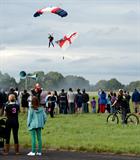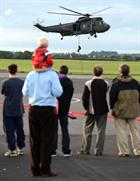Merryfield Opens its Gates to Somerset
In a small remote corner of Somerset, potential Royal Naval Aviators are taught the flying techniques and procedures needed to operate across the world, whether on the back of a Royal Navy Warship or the dusty deserts of Afghanistan, all Yeovilton based helicopters use this area.
But annually the gates of The Naval Air Station at Merryfield are flung open to let the local people see what the Navy gets up to on their door step. Merryfield is the satellite training airfield, used for intensive flying practices that cannot take place at its busy parent station, RNAS Yeovilton.
“Merryfield Open Evening is a chance for the local community to get a clearer understanding of what goes on here and why. Our flying training requirement are intense and we use Merryfield as a remote training site because much of the Commando and Maritime Lynx training cannot take place at Yeovilton which retains a significant fixed wing flying capability”, said Jeremy Greenop the Community Relations Officer for RNAS Yeovilton.
On show to the local community were some of the Aircraft who use the airfield on a day to day basis. The flying show including the Sea King Helicopter of the Commando Helicopter force and the Lynx from the Lynx Wildcat Maritime Force. Spectators were also treated to legendry icons of the Fleet Air Arm in the form of the Hawker Sea Fury and Yeovilton’s own Blackcats Helicopter display team. Static displays on the ground reflected the future in the form of a Wildcat and Merlin Mk 2 flown in by another user of Merryfield, Agusta Westlands, who routinely fly in to test some of their new developments from the near-by factory in Yeovil.
A crowd of just under 1500 people from the local area attended the evening, including Tomas Hunt who worked at Merryfield during the sixties, “It was a busy place with some really big hangars back then. I’ve not been back for a long time and I think is brilliant to see modern aircraft close up and talk with the pilots. It’s like having our own personal Airday, fantastic”.
The NAS at Merryfield occupies approximately 194 hectares, the majority of which consists of the airfield with its three runways. A small secure compound contains the Control Tower and Fire Station. But its not just flying that’s practiced here, the wooded areas around the runways is also used for Military training by both the Army and the Royal Marines.
Merryfield was built during the Second World War as an RAF base, but opened in 1942 with Its first occupants being the Americans who used it to build up for D Day on 06 June 1944. A large hospital was set up to receive casualties from France and a big part of the near by village of Ilton was given over to accommodation and support facilities. After the War various RAF and RN Squadrons occupied the airfield at different periods but it wasn’t until May 1972 when the Fleet Air Arm saw its potential as an excellent training facility so near to the expanding Yeovilton.
Today Merryfield plays a crucial role for the training and frontline naval air squadrons at Yeovilton. Auto rotations, fast stops, aerobatics, confined approaches and landings, load lifting, trooping drills, procedural flying, blank weapon drills, circuits and turns are all safely practised here, making it sometimes more active than a regular military airfield.





